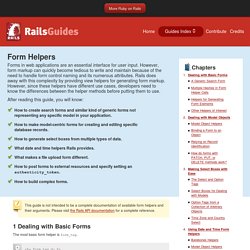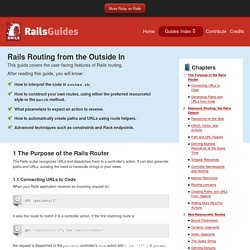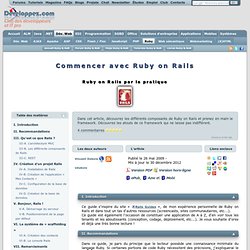

Ruby on Rails « Steve Sohcot's Technology Lessons Learned. Form Helpers. This guide is not intended to be a complete documentation of available form helpers and their arguments.

Please visit the Rails API documentation for a complete reference. 1 Dealing with Basic Forms The most basic form helper is form_tag. When called without arguments like this, it creates a <form> tag which, when submitted, will POST to the current page. For instance, assuming the current page is /home/index, the generated HTML will look like this (some line breaks added for readability): You'll notice that the HTML contains input element with type hidden. 1.1 A Generic Search Form One of the most basic forms you see on the web is a search form.
A form element with "GET" method,a label for the input,a text input element, anda submit element. To create this form you will use form_tag, label_tag, text_field_tag, and submit_tag, respectively. This will generate the following HTML: For every form input, an ID attribute is generated from its name ("q" in above example). 4.5. Populating the Database with seeds.rb. With the file db/seeds.rb, the Rails gods have given us a way of feeding default values easily and quickly to a fresh installation.

This is a normal Ruby program within the Rails environment. You have full access to all classes and methods of your application. So you do not need to enter everything manually with rails console in order to make the records created in the section called “create” available in a new Rails application, but you can simply use the following file db/seeds.rb: Rails Routing from the Outside In. 1 The Purpose of the Rails Router The Rails router recognizes URLs and dispatches them to a controller's action.

It can also generate paths and URLs, avoiding the need to hardcode strings in your views. 1.1 Connecting URLs to Code When your Rails application receives an incoming request for: it asks the router to match it to a controller action. Les meilleurs cours et tutoriels Ruby et Ruby on Rails. Créer une interface graphique avec Ruby/GTK. Pour le moment, nous n'avons vu que la fenêtre, qui est un conteneur ne pouvant contenir qu'un seul widget.

Il s'agissait du conteneur Gtk::Bin, dont Gtk::Window hérite. Mais ceci n'est pas suffisant pour faire une interface graphique, nous allons donc voir les autres conteneurs disponibles. Les boîtes sont un type de conteneur très simple, semblables à n'importe quel carton dans lequel on jette des revues : elles s'empilent les unes au dessus des autres, dans l'ordre dans lequel on les a jetées. Il existe des boîtes verticales (Gtk::VBox) et des boîtes horizontales (Gtk::HBox), qui héritent toutes les deux de l'objet générique Gtk::Box. Lorsque l'on crée une boîte, on indique si elle est homogène, c'est à dire si tous les éléments à l'intérieur ont droit au même espace, et on indique aussi l'espace vide laissé entre deux éléments. Voyons quelques exemples de boîtes Le résultat devrait ressembler à cela : En réalité, les méthodes pack_start et pack_end peuvent prendre plus de paramètres.
Commencer avec Ruby on Rails. Ce guide s'inspire du site « Rails Guides », de mon expérience personnelle de Ruby on Rails et dans tout un tas d'autres ressources (screencasts, sites communautaires, etc...).

Ce guide est également l'occasion de constituer une application de A à Z, d'en voir tous les tenants et les aboutissants (conception, codage, déploiement, etc...). Je vous souhaite d'ores et déjà une très bonne lecture ! Dans ce guide, je pars du principe que le lecteur possède une connaissance minimale du langage Ruby. Le kit du bon développeur Rails. Les tests sont une partie très importante de votre application Rails et il ne faut pas les négliger.

Il existe différentes gems vous permettant d'effectuer des tests unitaires, des tests d'intégration ou encore des tests de performance. La plus répandue d'entre elles est sans doute RSpec (vous pouvez obtenir des informations sur la page Github de RSpec) mais ce n'est pas sur cette dernière que je vais m'attarder, il y a déjà un certain nombre de documentations très bien faites. Capybara▲ Capybara est une gem permettant de tester votre site ou votre application tel que le ferait un utilisateur en navigant. Cela permet donc d'avoir des tests suivant des scénarios précis et adaptés à l'usage qui sera fait de votre site. Vous pouvez donc, au travers de vos tests, établir des scénarios de navigation afin de tester différentes parties de votre site ou application. Il est également possible de tester des éléments JavaScript avec Capybara.
MiniTest▲ group :test, :development do gem 'minitest'end.